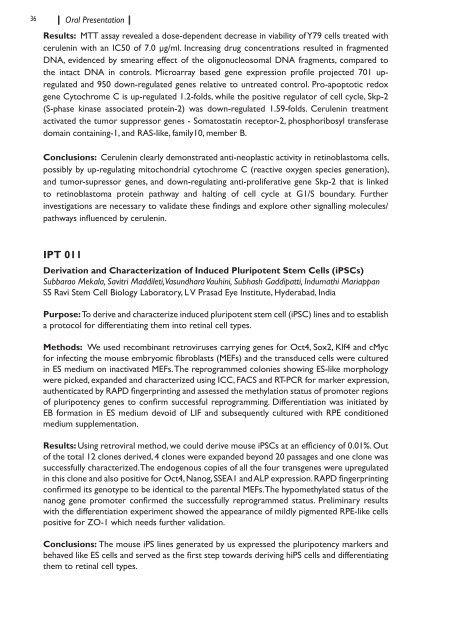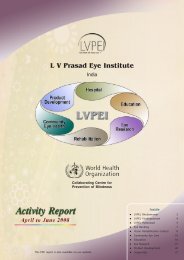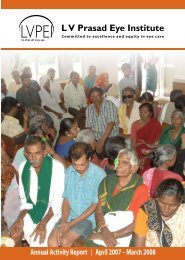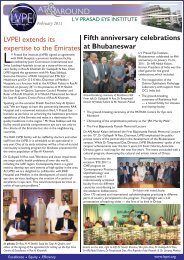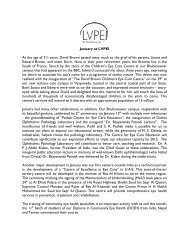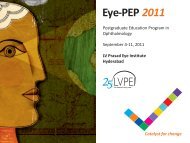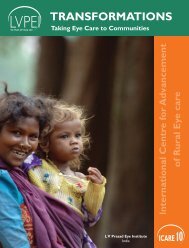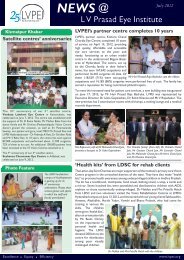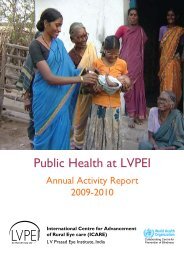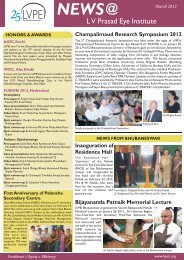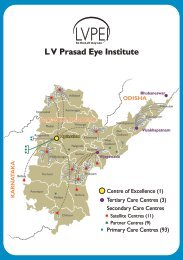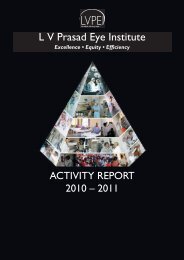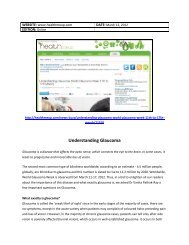IERG Abstracrt Book.indd - LV Prasad Eye Institute
IERG Abstracrt Book.indd - LV Prasad Eye Institute
IERG Abstracrt Book.indd - LV Prasad Eye Institute
Create successful ePaper yourself
Turn your PDF publications into a flip-book with our unique Google optimized e-Paper software.
36 Oral PresentationResults: MTT assay revealed a dose-dependent decrease in viability of Y79 cells treated withcerulenin with an IC50 of 7.0 µg/ml. Increasing drug concentrations resulted in fragmentedDNA, evidenced by smearing effect of the oligonucleosomal DNA fragments, compared tothe intact DNA in controls. Microarray based gene expression profile projected 701 upregulatedand 950 down-regulated genes relative to untreated control. Pro-apoptotic redoxgene Cytochrome C is up-regulated 1.2-folds, while the positive regulator of cell cycle, Skp-2(S-phase kinase associated protein-2) was down-regulated 1.59-folds. Cerulenin treatmentactivated the tumor suppressor genes - Somatostatin receptor-2, phosphoribosyl transferasedomain containing-1, and RAS-like, family10, member B.Conclusions: Cerulenin clearly demonstrated anti-neoplastic activity in retinoblastoma cells,possibly by up-regulating mitochondrial cytochrome C (reactive oxygen species generation),and tumor-supressor genes, and down-regulating anti-proliferative gene Skp-2 that is linkedto retinoblastoma protein pathway and halting of cell cycle at G1/S boundary. Furtherinvestigations are necessary to validate these findings and explore other signalling molecules/pathways influenced by cerulenin.IPT 011Derivation and Characterization of Induced Pluripotent Stem Cells (iPSCs)Subbarao Mekala, Savitri Maddileti, Vasundhara Vauhini, Subhash Gaddipatti, Indumathi MariappanSS Ravi Stem Cell Biology Laboratory, L V <strong>Prasad</strong> <strong>Eye</strong> <strong>Institute</strong>, Hyderabad, IndiaPurpose: To derive and characterize induced pluripotent stem cell (iPSC) lines and to establisha protocol for differentiating them into retinal cell types.Methods: We used recombinant retroviruses carrying genes for Oct4, Sox2, Klf4 and cMycfor infecting the mouse embryomic fibroblasts (MEFs) and the transduced cells were culturedin ES medium on inactivated MEFs. The reprogrammed colonies showing ES-like morphologywere picked, expanded and characterized using ICC, FACS and RT-PCR for marker expression,authenticated by RAPD fingerprinting and assessed the methylation status of promoter regionsof pluripotency genes to confirm successful reprogramming. Differentiation was initiated byEB formation in ES medium devoid of LIF and subsequently cultured with RPE conditionedmedium supplementation.Results: Using retroviral method, we could derive mouse iPSCs at an efficiency of 0.01%. Outof the total 12 clones derived, 4 clones were expanded beyond 20 passages and one clone wassuccessfully characterized. The endogenous copies of all the four transgenes were upregulatedin this clone and also positive for Oct4, Nanog, SSEA1 and ALP expression. RAPD fingerprintingconfirmed its genotype to be identical to the parental MEFs. The hypomethylated status of thenanog gene promoter confirmed the successfully reprogrammed status. Preliminary resultswith the differentiation experiment showed the appearance of mildly pigmented RPE-like cellspositive for ZO-1 which needs further validation.Conclusions: The mouse iPS lines generated by us expressed the pluripotency markers andbehaved like ES cells and served as the first step towards deriving hiPS cells and differentiatingthem to retinal cell types.


